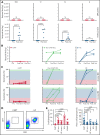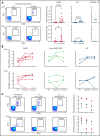Vaccine-induced T-cell responses against SARS-CoV-2 and its Omicron variant in patients with B cell-depleted lymphoma after CART therapy
- PMID: 35537186
- PMCID: PMC9135504
- DOI: 10.1182/blood.2022016175
Vaccine-induced T-cell responses against SARS-CoV-2 and its Omicron variant in patients with B cell-depleted lymphoma after CART therapy
Abstract
Patients receiving CD19 CAR T-cell therapy for relapsed/refractory lymphoma experience prolonged and profound B-cell aplasia and hypogammaglobulinemia, placing them at a higher risk for severe COVID-19. Independently, Oh et al and Atanackovic et al demonstrate that despite attenuated humoral response to mRNA-based vaccines, patients demonstrate normal or heightened functional T-cell responses, including antiviral T-cell activity against SARS-CoV-2 variants including Omicron. Collectively, these data reinforce the importance of COVID-19 vaccination following CD19 CAR T-cell therapy, despite long-term B-cell aplasia.
Figures


Comment in
-
Buckling up against COVID-19 after CAR T-cell therapy.Blood. 2022 Jul 14;140(2):85-87. doi: 10.1182/blood.2022016855. Blood. 2022. PMID: 35834284 Free PMC article. No abstract available.
References
Publication types
MeSH terms
Substances
Supplementary concepts
Grants and funding
LinkOut - more resources
Full Text Sources
Medical
Miscellaneous

